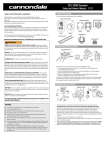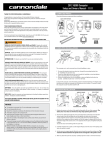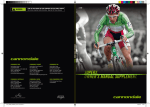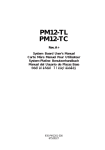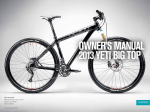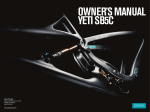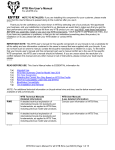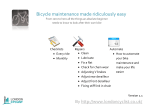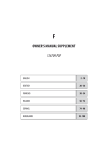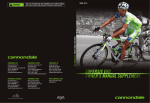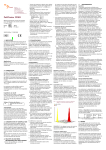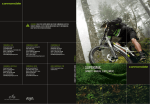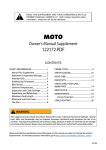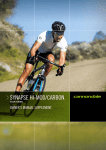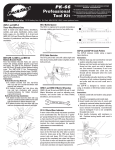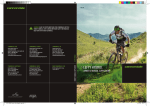Download SLICE RS. - Cannondale
Transcript
127399 WARNING! READ THIS SUPPLEMENT AND YOUR CANNONDALE BICYCLE OWNER’S MANUAL. BOTH CONTAIN IMPORTANT SAFETY INFORMATION. KEEP BOTH FOR FUTURE REFERENCE. CANNONDALE EUROPE CANNONDALE UK Cycling Sports Group, Inc. 172 Friendship Road, Bedford, Pennsylvania, 15522-6600, USA (Voice): 1-800-BIKE-USA (Fax): 814-623-6173 [email protected] Cycling Sports Group Europe, B.V. mail: Postbus 5100 visits: Hanzepoort 27 7570 GC, Oldenzaal, Netherlands (Voice): +41 61.4879380 (Fax): 31-5415-14240 [email protected] Cycling Sports Group Vantage Way, The Fulcrum, Poole, Dorset, BH12 4NU (Voice): +44 (0)1202 732288 (Fax): +44 (0)1202 723366 [email protected] CANNONDALE AUSTRALIA CANNONDALE JAPAN WWW.CANNONDALE.COM Cycling Sports Group Unit 8, 31-41 Bridge Road Stanmore NSW 2048 Phone: +61 (0)2 8595 4444 Fax: +61 (0) 8595 4499 [email protected] Namba Sumiso Building 9F, 4-19, Minami Horie 1-chome, Nishi-ku, Osaka 550-0015, Japan (Voice): 06-6110-9390 (Fax): 06-6110-9361 [email protected] © 2012 Cycling Sports Group 127399 (09/12) OWNER’S MANUAL SUPPLEMENT SLICE RS CANNONDALE USA SLICE RS. OWNER’S MANUAL SUPPLEMENT. In this supplement, particularly important information is presented in the following ways: WARNING NOTICE TIP Indicates a hazardous situation which, if not avoided, could result in death or serious injury. Indicates special precautions that must be taken to avoid damage. A TIP provides helpful information. This manual meets EN standards 14764, 14766, and 14781. Vélo certifié conforme aux exigences du décret N 95-937 du 24 août 1995 norme NFR030 127399.PDF SAFETY INFORMATION Important Composites Message About This Supplement Cannondale Owner’s Manual Supplements provide important model specific safety, maintenance, and technical information. They are not replacements for your Cannondale Bicycle Owner’s Manual. This supplement may be one of several for your bike. Be sure to obtain and read all of them. If you need a manual or supplement, or have a question about your bike, please contact your Cannondale Dealer immediately, or call us at one of the telephone numbers listed on the back cover of this manual. You can download Adobe Acrobat PDF versions of any Cannondale Owner’s Manuals or Supplements from our website: www.cannondale.com. ■ This manual is not a comprehensive safety or service manual for your bike. ■ This manual does not include assembly instructions for your bike. ■ All Cannondale bikes must be completely assembled and inspected for proper operation by a Cannondale Dealer before delivery to the owner. WARNING This supplement may include procedures beyond the scope of general mechanical aptitude. Special tools, skills, and knowledge may be required. Improper mechanical work increases the risk of an accident. Any bicycle accident has risk of serious injury, paralysis or death. To minimize risk we strongly recommend that owners always have mechanical work done by an authorized Cannondale retailer. WARNING Your bike (frame and components) is made from composite materials also known as “carbon fiber.” All riders must understand a fundamental reality of composites. Composite materials constructed of carbon fibers are strong and light, but when crashed or overloaded, carbon fibers do not bend, they break. For your safety, as you own and use the bike, you must follow proper service, maintenance, and inspection of all the composites (frame, stem, fork, handlebar, seat post, etc.) Ask your Cannondale Dealer for help. We urge you to read PART II, Section D. “Inspect For Safety” in your Cannondale Bicycle Owner’s Manual BEFORE you ride. YOU CAN BE SEVERELY INJURED, PARALYZED OR KILLED IN AN ACCIDENT IF YOU IGNORE THIS MESSAGE. Intended Use ASTM F2043 Suitable for road riding (only) The intended use of all models is ASTM CONDITION 1, High-Performance Road. WARNING UNDERSTAND YOUR BIKE AND ITS INTENDED USE. USING YOUR BIKE THE WRONG WAY IS DANGEROUS. Please read your Cannondale Bicycle Owner’s Manual for more information about Intended Use and Conditions 1-5. 127399 (09/12) 1 Inspection & Crash Damage Of Carbon Frames/Forks Bicycle Repair / Work Stands The clamping jaws of a bike stand can generate a crushing force strong enough to seriously damage your frame. WARNING NOTICE AFTER A CRASH OR IMPACT: Inspect frame carefully for damage (See PART II, Section D. Inspect For Safety in your Cannondale Bicycle Owner’s Manual. ) Do not ride your bike if you see any sign of damage, such as broken, splintered, or delaminated carbon fiber. ANY OF THE FOLLOWING DELAMINATION OR DAMAGE: ■ ■ ■ ■ MAY INDICATE A An unusual or strange feel to the frame Carbon which has a soft feel or altered shape Creaking or other unexplained noises, Visible cracks, a white or milky color present in carbon fiber section Continuing to ride a damaged frame increases the chances of frame failure, with the possibility of injury or death of the rider. Repainting Or Refinishing WARNING Repainting, painting over, retouching, or refinishing your frame or fork can result in severe damage leading to an accident. You can be severely injured, paralyzed or killed. Refinishing chemicals : Solvents, and strippers can attack, weaken, or destroy the important composite chemical bonds holding your frame together. Using abrasives or sanding the frame/fork structure, original paint, decals, or coatings through the use of mechanical actions such as plastic or glass bead blasting or other abrasive methods such as sanding or scraping can remove frame material or weaken it. 2 Never place your bike in a bike stand by clamping the frame. Place your bike in a stand by extending the seat post and positioning the stand clamp on the extended seat post. Don’t extend beyond the MINIMUM INSERT line marked on the seat post. Since your carbon seat post can also be damaged by clamping force, adjust the stand clamp for the minimum clamping force needed to secure the bike. Also, before clamping, clean the post and protect the seat post finish with a rag. If you have an old un-used seat post, use it instead of your regular post to mount your bike in a stand. Tightening Torques Correct tightening torque for the fasteners (bolts, screws, nuts) on your bicycle is very important to your safety. Correct tightening torque for the fasteners is also important for the durability and performance of your bicycle. We urge you to have your Dealer correctly torque all fasteners using a torque wrench. If you decide to torque fasteners yourself always use a torque wrench. Find Tightening Torque Information The wide range of bicycle models and components used means that a listing of tightening torque would be out of date by the time it was published. Many fasteners should be installed with a thread locking adhesive such as Loctite®. To determine correct tightening torque and any adhesive application for a fastener we ask you to check: • Markings on the component. Many components are marked. On-product marking is becoming common. • Torque specs in the component instructions shipped with your bicycle. manufacturers • Torque specs listed on the websites of component manufacturers. • With your Dealer. Dealers have access to current data and have experience with correct torque for most fasteners. 127399.PDF Trainers Water Bottles If you ride a trainer that requires removal of the front wheel and clamps the fork dropouts: Be sure your fork quick release is tight! Relative movement will wear parts, weaken and damage your bike. Side impacts to a water bottle or cage can result in damage threaded inserts due to the leverage on a very small area. In a crash, certainly the last thing you should be worried about is saving the threaded inserts in your frame. However, when you are storing or transporting your bike, take steps to prevent situations where a water bottle may be hit or bumped by a strong force that would cause damage. Remove bottle and cage when you are packing your bike for travel. If you ride a trainer that holds the bike up by clamping the rear quick release between two cones: Take off the nice, lightweight quick release that came with your bike. Substitute a heavy, classic all steel quick release and clamp it tight! Relative movement will wear parts, weaken and damage your bike. Note that many modern quick releases will not fit the clamping cones in this kind of trainer because their shapes are incompatible. Be particularly cautious with a carbon frame or fork. Carbon is relatively soft, not abrasion resistant. If there is any relative movement, carbon will wear quickly. If you ride a trainer a lot, consider using an old bike: Corrosion from sweat will take it’s toll. Weight is irrelevant. Save wear on your expensive components. Ask you dealer for help with trainers, the right one and the correct way to use it. NOTICE TRAINERS - Improperly mounting a bike in a trainer, or using one that is not compatible with your particular bike frame can cause serious damage. WATER BOTTLES - An impact, crash, or loose bottle cage can result in damage to your frame. This kind of damage is not covered by the Cannondale Limited Warranty. Periodically check the attachment of the bottle cage; tighten the cage bolts if necessary. Don’t ride with a loose bottle cage. Riding with loose cage bolts can produce a rocking motion or vibration of the attached cage. A loose cage will damage the insert and possibly lead to the inserts to pull out. It may be possible to repair a loose insert, or install another insert only if the frame is undamaged. Replacement requires the use of a special tool. If you notice damage to the threaded insert, please ask your Cannondale Dealer for help. Building Up A Frameset Before building up a frameset, consult with your Cannondale Dealer and the component manufacturers, and discuss your riding style, ability, weight, and interest in and patience for maintenance. Make sure the components chosen are compatible with your bike and intended for your weight and riding style. Generally speaking, lighter weight components have shorter lives. In selecting lightweight components, you are making a trade-off, favoring the higher performance that comes with less weight over longevity. If you choose more lightweight components, you must inspect them more frequently. If you are a heavier rider or have a rough, abusive or “go for it” riding style, buy heavy duty components. Read and follow the component manufacturers warnings and instructions. 3 Aerodynamic Handlebars Aerodynamic or “Triathlon” handlebar extensions are fitted to some triathlon or racing bikes. They are also added by customers. Understand that when riding on these extensions your steering and braking are adversely affected. When on the extensions, most riders find it hard to look back over their shoulder without swerving, inadvertently steering. Some riders find it harder to move their head/neck to see forward. Be sure to practice riding with aero handlebar extensions on hazard and traffic free roads. Practice the transition from having your hands on the extensions to having your hands on the regular handlebars and brake levers. WARNING DO NOT RIDE ON THE AERO HANDLEBAR EXTENSIONS IN TRAFFIC OR ON DIFFICULT ROADS. Ride on the aero handlebar extensions only when the road is clear of traffic and hazards and you have a long line of sight. When using the extensions understand that you are compromising steering and braking in favor of speed. If you need to take evasive steering or braking action while on the extensions you could have an accident, with risk of serious injury, paralysis or death. Aerodynamic handlebars and extensions are a design trade-off which positions you further forward than on a conventional road bike, so: CONVENTIONAL ROAD ■ Overly hard use of the front brakes will pitch you forward, off the bike, more easily. ■ Rear braking performance will not equal that of a conventional road bike. AERODYNAMIC extensions brake levers Lower/ forward on extensions 4 When braking hard on any bike, including time trial or triathalon, you must shift weight back to allow front brake use without pitching yourself forward, off the bike. Shifting weight back allows more rear braking effect before the rear wheel begins to skid when braking hard, or braking on a steep downhill. See Part 1, Section 4C. of your Cannondale Bicycle Owner’s Manual. Aerodynamic handlebars and extensions are intended for racing and competition in time trial and triathalon and are poorly suited for riding in cities or congested urban areas where conflicts with cars will frequently require panic braking. 127399.PDF BOTTOM BRACKET 1. 11. 1. 2. 3. 3. 9. 7. 8. 12. 5. 4. 10. Chainstay-to-BB Rear Derailleur Internal Brake Housing Length = 640mm 1. 2. 3. 4. 5. Front Derailleur Cable Rear Derailleur Cable Rear Brake Cable Cable Guide Rear Brake Flexible Housing 13. 14. 13. 6. Please Note: This illustration shows the PF30 parts removed. Use Cannondale kit KP197/SRM or FSA PF30 with alloy cups. Other PF30 BB’s may interfere with the guide (4). 6. Rear Brake Noodle 7. Housing Ferrule 8. Rear Dearailleur Housing 9. Front Derailleur Exit 10.Tubing Section 11.DI2 FD Cable Exit 12.DI2 Battery Cable BB Entry 13.DI2 Battery Mount 14.DI2 Battery Cable Entry Hole 5 SEAT POST Maintenance: Periodically, remove the seat post and the clamp assembly to clean, inspect for damage and re-new the application of grease and carbon gel. Removal To remove the seat post, use an 4mm Allen key to turn the 5mm wedge bolt counter-clockwise to loosen it. When bolt is loose simply lift the seat post up out of the seat tube. Then lift out the wedge assembly out of the frame socket. Installation: Before inserting the seat post into the frame, use a clean shop towel to wipe out any reisdual carbon gel paste from the inside the seat tube. Do not use any spray cleaners or solvents. Apply fresh carbon friction gel to the seat post and place a little bit inside the seat tube. Clean the wedge assembly and lightly grease the parts. Insert the loosened asembly into the frame, then carefully insert the seat post into the frame. Set the saddle height, and tighten the clamp bolt to 5 Nm, (44.0 InLbs) with a torque wrench. Insert Limits & Sizing a Seat Post The minimum insert depth the seat post must be inserted into the frame is 80mm. This length is marked by a line on the seat post. The total length of seat post may be inserted into the frame without bottoming out is about 110mm. However, this length will vary with the frame size and should be checked in each frame for a frame. A large size frames will accomodate more seat post length than a smaller size frame. 6 To check the depth, carefully slide a seat post into the frame until it stops; then lift it up 5mm. NOTICE A seat post should not be bottomed out inside the frame at anytime. Have your Cannondale Dealer size the seat post appropriately. If the seat post must be cut, use a cutting guide and a carbon saw blade. Lightly sand the edges of the cut seat tube with light sandpaper. Re-mark the minimum insert line on the post. WARNING THE SEAT POST MUST ONLY BE CUT BY A PROFESSIONAL BIKE MECHANIC. Incorrectly cutting the seat post can result in damage leading to an accident. Reversing the Seat Post The seat post may be reversed in the frame resulting in a Time Trial Triathalon or UCI Time Trial saddle position. The saddle will have to be removed and the assembly reconfigured. The changes requires that the upper clamp be and hardware be reversed. However, the relief slot (a) of the lower clamp which is larger always must face the front of the bike. Optional Tool - KP282/ An optional seat post tool KP282/ is available to be installed in place of the seat post. See Replacement Parts. 127399.PDF KP274/ Saddle angle adjust. FRONT OF BIKE UCI Time Trial Triathlon Time Trial (a) UPPER CLAMP LOWER CLAMP FRONT OF BIKE 5 Nm, 44 InLbs KP273/WHT KP273/BLE Apply light grease to wedge assembly. Apply carbon gel KF115/ to seat post. 80mm Minimum Insert “80mm MIN. INSERT” 110mm Maximum Insert Park Tool SG-8: www.parktool.com/product/threadless-saw-guide-for-carbon-composite-forks-sg-8 Park Tool CSB-1: www.parktool.com/product/carbon-saw-blade-csb-1 7 FORK BEARINGS INSTALL 3. KF281/ (a) 1. Loctite 7471 Loctite 609 Loctite 7471 Loctite 609 2. (a) 1. 2. 3. Upper Bearing Lower Bearing Bearing Press Tool (a) - Red Bearing Seal direction Procedure: The two fork bearings (upper and lower) are a seal cartridge type. Replacement is required only when the bearings become damaged. These bearings are included in the headset kit KP270/. 1. Before pressing the bearings with the tool, clean both of the fork bearing seats with a clean shop towel and alcohol. 2. Apply Loctite 7471 Primer to the outer bearing race and the fork bearing seat. 3. Apply Loctite 609 to the outer bearing race and the fork bearing seat. Use the bearing press tool KF281/ to press each bearing into the fork bearing seat until bottomed, then remove the tool. 8 The red seal of the upper bearing faces up. The red seal of the lower bearing faces down. Allow the Loctite to cure appropriately before installing the fork. For Loctite instructions: Loctite 7471: http://tds.loctite.com/tds5/docs/7471-EN.PDF Loctite 609: http://tds.loctite.com/tds5/docs/609-EN.pdf 127399.PDF FORK INSTALL 1. Loctite 243 34.0 Nm, (25.0 Ft Lbs) 2. 15mm Use a 14mm hex to tighten the bolts. 4. Tubing installed (COLOR): RED - Drive Side / Rear Brake BLUE - Middle / Rear Derailleur BLACK - Non-Drive Side / Front Derailleur 1. 2. 3. 4. Upper Bolt Washer Lower Bolt Internal Cable Guide 3. Loctite 243 34.0 Nm, (25.0 Ft Lbs) Procedure: 1. First, bearings should be installed and Loctite 609 permitted to cure according to instructions. 5. Install 1 to 3 washers (2) between the frame and the stem / upper bearing to take up the space. 2. Make sure the internal cable guide (4) is threaded 15mm from the top of the headtube insert and that tubing sections are installed through it to the BB cable guide correctly. 6. Apply Loctite 243 to the threads and install the upper bolt (1) and finger tighten it until the bolt shoulder touches the inner race of the upper fork bearing. 7. 3. Slide the fork onto the frame 4. Apply Loctite 243 to the threads and install the lower bolt (3) and finger tighten it until the bolt shoulder touches the inner race of the lower fork bearing. Tighten both upper and lower bolts uniformly with a torque wrench to 34.0 Nm, (25 ft,Lbs). Loctite 243: http://tds.loctite.com/tds5/docs/243%20NEW-EN.PDF 9 BRAKE SET-UP INFORMATION STEM CABLE GUIDE - The front brake cable enters the head tube cable guide in the non-drive side forward hole. The rear brake cable enters the head tube cable guide in the drive side forward hole. HANDLEBAR HOUSING - The brake housing loop lengths between the handlebar and the stem guide should be determined after the handlebar stem and aero extensions positions are set. When cutting the housing between the extensions and the guide, the loop should be a smooth curve enabling necessary handlebar movement and smooth cable action inside (i.e. no bending turns which will negatively influence brake cable movement). FLEXIBLE HOUSING LENGTHS - The flexible brake housing inside the head tube for the front brake is a specific length for each frame size. The cut lengths for the frame sizes are given in the table. This flexible housing extends from the bottom of the head tube cable guide through the inner head tube cable guide to the 90° aluminum noodle. The flexible housing for the rear brake which exits the bottom bracket cable guide is 62mm for all frame sizes. The teflon tubing length is 80mm for all sizes. It should be trimmed as noted in the rear brake illustrations. TEFLON TUBING - A section of 4mm tubing is used inside the brake cable flexible housing. This teflon tube is flanged at the top to prevent the tubing from sliding out of the housing with cable movement. The tubing overall length extends to just beyond the 90° aluminum noodle. Terminating the tubing before the end of the noodle will create unwanted cable drag. Trim the tubing cleanly to avoid creating rough edges. Cable lubricant is applied inside the teflon tubing to reduce cable friction. Add a very small amount of cable lubricant inside the tube when changing it. CANTI BOSSES - Apply Loctite 271. Tighten to 8.0 Nm, (70 InLbs). 10 127399.PDF INSTALLING THE CALIPER ARMS - Apply light grease to the canti-bosses, arm bushings , springs, spring plates and spring pockets in the arms before installation onto the fork. Be sure to insert the spring plate so that the flat interfaces with the adjusting allen screws inside the brake arms correctly. Insert the smaller spring end into the spring plate . The longer spring arm fits into the fork. Slide the drive side brake arm onto the canti-post first aligning the longer spring end with the middle hole in the fork. (The outer hole will increase the spring tension the most; selecting the inner hole will result in the least spring tension.) Apply Loctite 243 to the threads and tighten the mounting bolt to 5Nm, (44 InLbs). Using the same spring hole as selected in step 2, slide the non-drive side brake arm onto the canti-boss and tighten bolt to 5Nm,(44 InLbs). Slide the brake cable through the hole in the non-drive brake arm and secure with the cable anchor bolt. When the two arms are flush with the outside of the fork or chainstay – tighten the cable anchor bolt to 5Nm,(44 InLbs) SETTING THE PAD-TO-RIM CLEARANCE - The brake pad clearance with the wheel rim braking surface should be 2–3 mm. Use a combination of the 1 mm and 2mm spacers to set the pad reach. To ensure good thread engagement between the T-NUT and brake pad bolt, be sure to use the correct T-NUT. Make fine adjustments by adjusting the at brake cable. Be sure to reinstall the brake pad retaining pin if you change the T-NUT. 11 FRONT BRAKE 1. Loctite 243 2.0Nm, (18.0 InLbs) 2. 3. 4. SIZE 50 cm 52 cm 54 cm 56 cm 58 cm BLACK - FD BLUE - RD RED - RB 5. 7. 6. 5.0Nm, (44.0 InLbs) 5.0Nm, (44.0 InLbs) Loctite 243 5.0Nm, (44.0 InLbs) 12 5. 90mm 110mm 130mm 150mm 170mm 7. 108mm 128mm 148mm 168mm 188mm 127399.PDF 8. 10. 12. 11. 25. 22. 21. 9. Loctite 271 8.0Nm, (70.0 InLbs) 20. 19. 18. 14. 15. 17. 13. 24. 26. 23. 16. 1. Stem Cover Screws 2. Stem Cover 3. Stem Cable Guide 4. Internal HT Guide 5. Flexible Brake Housing 6. 90° aluminum noodle 7. Teflon Tubing 8. Brake Cable 9. Cantilever Boss 10.Spring 11.Spring Plate 12.Non-Drive Brake Arm 13.Drive brake Arm 14.Brake Pad Holder 15.T-Nut 16.Brake Pad 17.Pad Retaining Pin 18.Spherical Washer 19.2 mm Spacer 20.1 mm Spacer(s) 21.Arm Bolt Washer 22.Arm Bolt 23.Arm Mounting Bolt 24.Arm Bushing 25.Cable Anchor Bolt 26.Tension Adjust Screw 13 REAR BRAKE Loctite 243 2.0Nm, (17.0 InLbs) 24. 25. Loctite 243 2.0Nm, (17.0 InLbs) 2. 27. 26. 9. 4. 1. 19. 5.0Nm, (44.0 InLbs) 11. 14. 18. Loctite 243 23. 13. 12. 15. 16. 8. 17. 5.0Nm, (44.0 InLbs) 7. 6. 10. 5. 21. 22. 8. 20. 1. 2. 3. 4. 5. 6. 7. 8. 9. 14 BB Cable Guide Flexible Housing Teflon Tubing 90° Aluminum Noodle Cantilever Boss Spring Spring Plate (not shown) Bushing (not shown) Non-Drive Brake Arm Loctite 271 8.0Nm, (70.0 InLbs) 7. 10.Drive brake Arm 11.Brake Pad Holder 12.T-Nut 13.Brake Pad 14.Pad Retaining Pin 15.Spherical Washer 16.2 mm Spacer 17.1 mm Spacer(s) 18.Arm Mounting Bolt (10pt) 19.Cable Anchor Bolt 20.Tension Adjust Screw 21.Washer 22.Pad Mounting Bolt 23.BB Guide Nut 24.BB Guide Screw 25.Brake Arch 26.Washer 27.Screw 127399.PDF 3. 62 mm 80 mm 14. Trim front derailleur, rear derailleur shortly beyond the guide to make cable bend upward easier. Trim tubing shortly beyond the noodle end, not before. 15 STEM EXTENSIONS A KP277/10 1. “90mm” 2. B KP277/30 KP277/20 “110mm” “100mm” KP277/40 “120mm” 3. KF115/ 4. Loctite 242 5.0Nm, (44.0 InLbs) C 1. 2. 3. 4. 5. Stem Extension Base Handlebar Stem Cap Stem Bolts “A” STEM LENGTH 80 mm 90 mm 100 mm 110 mm 120 mm 5. “B” EXTENSION LENGTH -10 mm 20 mm 30 mm 40 mm “C” BOLT LENGTH 20 mm 30 mm 40 mm 50 mm 60 mm WARNING STEM & AERO HANDLEBAR EXTENSIONS: Use only one stem extension, no multiples. Use the correct bolt length for the length/height indicated in the table. Always clean and apply Loctite 242 to bolt threads. Tighten uniformly to the specified torque with a torque wrench. 16 127399.PDF AERO HANDLEBAR EXTENSION 1. 2. 3. 4. D KF115/ 6. 5. 7. E Loctite 242 8.0Nm, (71.0 InLbs) 8. 1. 2. 3. 4. 5. 6. 7. 8. FSA Extension 5mm Spacer 10mm Spacer 20mm Spacer Upper Clamp Base Handlebar Lower Clamp Clamp Bolt See Full Speed Ahead’s (FSA) assembly instructions for information on the set-up and adjustment of the extensions. FSA: http://www.fullspeedahead.com/ “D” SPACER STACK HEIGHT 0mm 5mm 10mm 15mm 20mm 25mm 30mm 35mm 40mm 45mm 50mm 55mm 60mm 65mm 70mm “E” BOLT LENGTH 25mm 25mm 25mm 40mm 40mm 40mm 55mm 55mm 55mm 70mm 70mm 70mm 85mm 85mm 85mm 17 REAR DROPOUTS 3. Loctite 243 2.0Nm, (17.0 InLbs) 2. 4. 3. 1. 2. 3. 4. 18 Rear Derailleur Hangar Mounting Screws Wheel Centering Screws Housing Exit Hole KP276/ 1. 127399.PDF REPLACEMENT PARTS The following replacement part kits are available through a Cannondale Dealer: KP283/ KP274/ KP273/WHT KP273/BLE KP279/WHT KP279/BLE KF115/ KP270/ KP280/ KP282/ KP277/___ KP278/ KP281/ KP276/ KP271/ KP272/ KP275/ KP197/SRM CODE DESCRIPTION CODE DESCRIPTION KP270/ KIT,HEADSET,SLICE RS KP277/30 KIT,STEM EXTENTION,SLICE RS KP271/ KIT,BRAKE,SLICE RS,FRONT CRB KP277/40 KIT,STEM EXTENTION,SLICE RS KP272/ KIT,BRAKE,SLICE RS,REAR CRB KP278/ KIT,STEM,FACEPLATE,SLICE RS KP273/WHT KIT,SEATPOST,SLICE RS KP279/WHT KIT,STEM, GUIDE COVER, SLICE RS KP273/BLE KIT,SEATPOST,SLICE RS KP279/BLE KIT,STEM, GUIDE COVER, SLICE RS KP274/ KIT,SEATBINDER,SLICE RS KP280/ KIT,GUIDE,CABLE H-TUBE SLICE RS KP275/ KIT,BB CABLEGUIDE,SLICE RS KP197/SRM KIT,BB,PRESSFIT 30, 68/73 SRM KP276/ KIT,DER HANGER,SLICE RS KF115/ KIT,GEL,DYNAMIC,CARBN SEATPOST KP277/10 KIT,STEM EXTENTION,SLICE RS KP281/ KIT,TOOL,HEADSET SLICE RS KP277/20 KIT,STEM EXTENTION,SLICE RS KP282/ KIT,TOOL,DUMMY SEATPOST,SLICE RS KP283/ KIT,STORAGE BOX,SLICE RS 19 GEOMETRY A O S R M N PQ B J D C F L KG E H Sizes (cm) A B C D E F G H I J K L M N O P Q R S Top Tube Seat Tube Length Seat Tube Angle (Degrees)* Head Tube Angle (Degrees) Chain Stay Length Fork Rake Bottom Bracket Height Wheelbase Trail Standover At Top Tube Midpoint Bottom Bracket Drop Front Center Head Tube Length Stack Reach Pad Stack Lowest Pad Stack Highest Pad Reach Shortest Pad Reach Longest I 50 50.4 50.0 52 51.9 51.0 54 53.4 53.0 56 54.9 55.0 58 56.4 57.0 *variable *variable *variable *variable *variable 71.5 ° 40.5 4.5 26.5 96.2 6.5 76.5 7.2 56.5 7.0 50.0 36.9 53.5 60.5 44.1 48.1 71.5 ° 40.5 4.5 26.5 97.8 6.5 77.5 7.2 58.0 8.0 51.0 38.2 54.5 61.5 45.4 49.4 71.5 ° 40.5 4.5 26.5 99.4 6.5 79.5 7.2 59.7 10.2 53.0 39.2 56.5 63.5 46.4 50.4 71.5 ° 40.5 4.5 26.5 101.0 6.5 81.5 7.2 61.3 12.3 55.0 40.1 58.5 65.5 47.3 51.3 71.5 ° 40.5 4.5 26.5 102.7 6.5 83.5 7.2 62.9 14.4 57.0 41.1 60.5 67.5 48.3 52.3 Pad stack and pad reach are measured to the center of the pad. Subtract 40mm for rear of pad. Fsa aero extensions and arm rests. * The slice rs seat post is reversible. A full range of angles from 74 to 79 degrees is achievable depending on the rider’s preference and/or the event. 20 127399 WARNING! READ THIS SUPPLEMENT AND YOUR CANNONDALE BICYCLE OWNER’S MANUAL. BOTH CONTAIN IMPORTANT SAFETY INFORMATION. KEEP BOTH FOR FUTURE REFERENCE. CANNONDALE EUROPE CANNONDALE UK Cycling Sports Group, Inc. 172 Friendship Road, Bedford, Pennsylvania, 15522-6600, USA (Voice): 1-800-BIKE-USA (Fax): 814-623-6173 [email protected] Cycling Sports Group Europe, B.V. mail: Postbus 5100 visits: Hanzepoort 27 7570 GC, Oldenzaal, Netherlands (Voice): +41 61.4879380 (Fax): 31-5415-14240 [email protected] Cycling Sports Group Vantage Way, The Fulcrum, Poole, Dorset, BH12 4NU (Voice): +44 (0)1202 732288 (Fax): +44 (0)1202 723366 [email protected] CANNONDALE AUSTRALIA CANNONDALE JAPAN WWW.CANNONDALE.COM Cycling Sports Group Unit 8, 31-41 Bridge Road Stanmore NSW 2048 Phone: +61 (0)2 8595 4444 Fax: +61 (0) 8595 4499 [email protected] Namba Sumiso Building 9F, 4-19, Minami Horie 1-chome, Nishi-ku, Osaka 550-0015, Japan (Voice): 06-6110-9390 (Fax): 06-6110-9361 [email protected] © 2012 Cycling Sports Group 127399 (09/12) OWNER’S MANUAL SUPPLEMENT SLICE RS CANNONDALE USA SLICE RS. OWNER’S MANUAL SUPPLEMENT.























